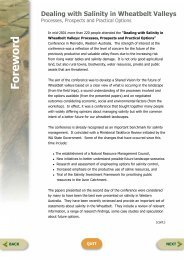Salinity situation statement Tweed River and Gnowergerup Brook
Salinity situation statement Tweed River and Gnowergerup Brook
Salinity situation statement Tweed River and Gnowergerup Brook
Create successful ePaper yourself
Turn your PDF publications into a flip-book with our unique Google optimized e-Paper software.
<strong>Salinity</strong> <strong>situation</strong> <strong>statement</strong>: <strong>Tweed</strong> <strong>River</strong> & <strong>Gnowergerup</strong> <strong>Brook</strong> WRT 41 Water Resource Technical Series<br />
4 Catchment modelling<br />
4.1 What is modelling?<br />
A model is a mathematical tool to simulate flow <strong>and</strong> salinity changes that may result from<br />
l<strong>and</strong>-use or climate changes. An effective model incorporates a good underst<strong>and</strong>ing of<br />
l<strong>and</strong>scape processes, reliable input data <strong>and</strong>, when these do not exist, sound assumptions or<br />
data from other sources.<br />
In the case of the <strong>Tweed</strong> <strong>River</strong> catchment, as good quality calibration <strong>and</strong> validation data<br />
were not available, the model was constructed around assumptions <strong>and</strong> data taken from the<br />
<strong>Gnowergerup</strong> <strong>Brook</strong> catchment.<br />
Subcatchments were modelled to validate <strong>and</strong> build confidence in the modelled results by<br />
comparing observed data with projections at the Jayes Road gauging station. The results are<br />
the best projections of catchment processes relating to salinity <strong>and</strong> streamflows that we are<br />
able to gain because the models are closely tied to ‘real world’ data.<br />
4.2 The LUCICAT Live model<br />
To describe the current salinity <strong>situation</strong> <strong>and</strong> simulate future salinity trends it is essential to<br />
know the salinity, volume of water (streamflow) <strong>and</strong> mass of salt (salt load) from these<br />
subcatchments. These three parameters are the key indicators in describing catchment<br />
stream salinity.<br />
Projections of streamflow, salt load <strong>and</strong> salinity were derived using the dynamic L<strong>and</strong> Use<br />
Change Integrated Catchment model LUCICAT (Bari 2005). The model can provide longterm<br />
simulations of various l<strong>and</strong>-use scenarios <strong>and</strong> includes the effects of salt leaching. The<br />
model is run until hydrological equilibrium is reached for a given scenario. In some cases the<br />
model needs to be run for simulation periods of more than 100 years before catchment<br />
hydrological equilibria are reached.<br />
The model calculates the daily salt <strong>and</strong> water balances following l<strong>and</strong>-use changes across a<br />
range of catchment scales. It takes into account the spatial distribution of topography,<br />
vegetation characteristics, basic soil types, rainfall, evaporation <strong>and</strong> soil salt storage.<br />
The model’s main feature is division of a catchment into subcatchments called management<br />
units <strong>and</strong> even smaller areas called response units (Fig. 18). Response units are the key<br />
component or building block of the model (Appendix E).<br />
22 Department of Water













